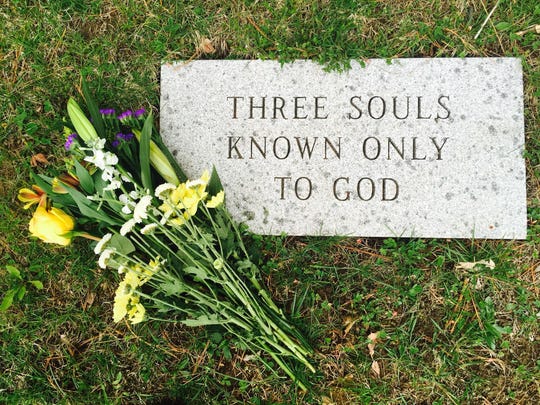
The mother and daughter rushed home to call the sheriff’s office. And by nightfall, Middlebury Sheriff Ralph G. Sweet and Addison County State’s Attorney John T. Conley, along with several residents, uncovered the skeletal remains of a mother approximately 35-45 years old and her two children, one about 9 to 11 years old and the other 13 to 15. All three had a .38-caliber Colt automatic bullet hole in the skull.
The bodies had been wrapped together in a blanket and a green canvas awning with pulleys still attached. The road they had been found on led to Brookins/Blackmer hunting camp. The bodies had been dumped unceremoniously under a pine tree. A small tree root, about a half to three-quarters of an inch thick, had grown over the leg of one of the victims. Investigators believed the bodies had been there for two or three years.
Other evidence included a “few hanks of matted hair,” described as both blond and dark, possibly auburn, with some of the strands being several inches long; a small piece of a woman’s silk dress; badly disintegrated remnants of a black, possibly green, and buff striped awning; four small block pulleys; the corner of a woolen blanket; and the snap from an automobile side curtain. A flattened .38 caliber copper jacketed bullet, consistent with a Colt automatic, was also found under one of the skulls.
Detective Franzoni from the Vermont Attorney's General Office was now on the case. He started hunting down persons of interest. R.R. Luding of Buffalo, New York was a guest of the Middlebury Hotel. He had shown “great interest in the finding of the skeletons” and reportedly followed investigators from Middlebury to Burlington in an automobile with Indiana license plates. Police were asked to keep a lookout for him, but the search was discontinued almost as soon as it started.
Next came Irving or Arthur Denton. Denton showed up in August 1931 buying high-price items, including a Ford automobile and a property on Starksboro Road, and paying for them in cash. He also whitewashed his property’s windows, blackened its lights, and warned neighbors to keep away. In February 1932, Denton abruptly left town ordering the sale of his property with the money going to the Pacific National Bank in Seattle, Washington. The neighbor living closest to the crime scene stated that 1932 was the year a dank odor of “decaying flesh” came from the woods.
Then there was Harold Young. He came to Burlington in 1929 to operate a store on the corner of Monroe and Champlain streets, which was part of the Grand Union Tea Company. It was believed that he was a bootlegger or in the moonshine business not too far from Buffalo, New York. People who knew Young said that he claimed “it got too hot” for him there. He also was known to own a .38 caliber Colt. John Deyette, who owned the building where the store was located, said Young was taken back after receiving a notice that his wife and child, a girl about 11 years old, planned to join him in Burlington. Soon after their arrival, Deyette told authorities that Young left with his wife and daughter for three days and returned without them. Soon after, Young also left the area.
The case went cold until January 1938.
The case went cold until January 1938.
Harvard scientists who examined the remains while they were in Boston provided a more detailed report about the victims. Due to the results of the examination, Detective Franzoni thought that the victims might be Mrs. Cora Golden and her children, Charles Jr. and Beulah Elizabeth of Milton.
Cora disappeared in 1923 with her children when she was 31 years old. At the time, Charles Jr. was 7 and Beulah was 4. If Cora and her children were killed seven years after they disappeared, the ages and year of death would align with Harvard’s estimates.
The Milton's farmhand had also disappeared around the same time as the Goldens. Detective Franzoni was able to trace Cora, the farmhand, Joseph Carter, and the children as having spent time in Hartford, Connecticut before coming back to Vermont in 1929.
In April 1938, Detective Franzoni found Beulah living with an adoptive family in Connecticut. Franzoni then tracked down Cora and Joseph Carter, and learned they had a child together in 1924. That child was a boy, the gender Harvard scientists concluded both children to be.
It wasn't until decades later that it was found out that Cora and the farm hand were still alive and well. They used pseudonyms Cora LaFlash and Thomas Charest in Vermont and had a son named Francis. The 1930 federal Census shows the Charest family residing in New York and following Elizabeth “Cora” Charest’s death in 1938, Thomas, Charles and Francis all eventually return back to Vermont. DNA testing of a living relative of Buelah show the three unidentified persons are neither Buelah’s mother nor her brothers.
Neither the victims, nor their killer, were identified. So, the victims’ bones were stored in boxes at the state medical examiner’s office.
Now the DNA is so degraded that it is of little use.
In 2015, a forensic sculpture class at the New York Academy of Art, with assistance from the National Center for Missing and Exploited Children, completed facial reconstructions of the victims, using the remains as their guide.
 Once the facial reconstructions were complete, the remains were interred during a solemn ceremony at the Prospect Cemetery in East Middlebury
Once the facial reconstructions were complete, the remains were interred during a solemn ceremony at the Prospect Cemetery in East Middlebury


No comments:
Post a Comment